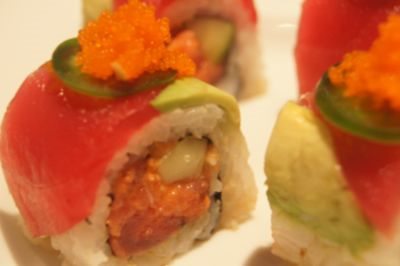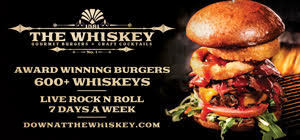
On this week’s segment on WMFE-FM, Scott talks with 90.7’s Nicole Creston about all things sushi. You can hear Scott’s segments at 5:45 Friday afternoon and again Saturday at 9:35 a.m. Or you can listen to this and past podcasts at this link.
There has been a huge explosion of sushi joints in this area, which, if you really think about it, could be pretty messy. Set off a couple of dynamite rolls and you could have nori, gari and daikon all over the place. And if none of those words mean anything to you, you should know that sushi is hotter than a handful of wasabi.
And if you don’t know what that is either, you’ve come to the right place. Here is a primer on sushi, sashimi and how to eat it, plus a few of my favorite places to try it.
But first, let’s go over some of the terms and talk a little bit about the whole experience. These are just some basic things you should be aware of before someone gives you a handful of wasabi and you take a bite.
The first thing you need to know is that sushi does not mean raw fish. True, most of what you’ll find in a sushi joint features raw fish, but that isn’t the definition. Sushi is actually the term for vinegared rice that is a part of most items served from a sushi bar. In the case of rice served in Japanese restaurants, it is a vinegar fermented from rice. A little sugar is added to prevent a tart taste.
Sushi started out over a thousand years ago as a way to preserve fish. Raw fish was pressed with rice and salt under a rock and left for a few weeks. It wasn’t until the 18th century that the current method of presenting sushi was “invented.” By the way, if you encounter any sushi restaurants today that are serving fish that have been lying around for a few weeks under a heavy rock, leave immediately.
Raw fish served without rice is called sashimi. Wrap it around some rice and you’ve got sushi again. Fish pressed on top of a wad of rice is called nigirizushi.
And not all sushi has raw fish, though it’s impossible to have sashimi without it. Some sushi feature cooked fish, and indeed some must be cooked for safety reasons. Most shrimp served in sushi bars, for instance, will be cooked, though it is possible to find a raw shrimp version. Soft-shell crab, often served in a roll called a spider, will be deep-fried. You just don’t want to go chomping on raw soft-shell crabs. Or spiders for that matter. Trust me on this.
And for vegetarians, it is possible to get sushi rolls with no fish at all and still have more than just a handful of rice. There is a nigiri sushi that features a sort of egg omelet on top of rice, for vegetarians who include eggs in their diet, but most vegetarian offerings will be available in rolls.
There are two types of rolls, the maki sushi and the temaki sushi. Both are made with nori, a papery substance made from seaweed. In maki, the ingredients are placed on the nori sheet and rolled up then sliced into thick rounds. Temaki is rolled up sort of like an ice cream cone and can be picked up and eaten.
In fact, you can eat all sushi with your hands, though chopsticks should be used for sashimi. But we’ll come back to etiquette in a moment.
Let’s talk about the sushi restaurant experience. When you enter the restaurant you’ll be asked if you want to sit at a table or at the sushi bar. Unless you have a very large group, choose to sit at the bar. That way you can see the fish that are available in the refrigerated case that separates the diners from the chef, you can ask questions of the sushi chef (itamae) and watch him or her in action. (It wasn’t so long ago that sushi chefs were exclusively men, but that gender barrier has been broken on several fronts, including California Grill and Tokyo Dining at Epcot.
Watching a good sushi chef is like watching an artist at work. And indeed good sushi is an artform in and of itself. Good chefs take years to learn the craft. Each fish requires a different method of slicing to accentuate its unique texture and taste. Think of it as dinner and a show.
Whether you sit at the bar or at a table, you’ll be presented with a dinner menu and a separate sheet for ordering sushi and sashimi. The sushi/sashimi sheet (say that five times really fast) is a long list of the various fish and rolls that are available. Fish are usually presented with their Japanese names, but almost always there is an English translation next to it. The sheet comes with a pencil that you use to make a mark next to your selections. Choose how many of each selection you want and tally it up in the far right column. If you’re not sure how to do it, ask your server for some help.
Even if you sit at the sushi bar, you should order through the waiter or waitress, although the sushi chef will be happy to answer questions. If you’re not familiar with the various types of fish, the chef will gladly point them out to you (another advantage to sitting at the bar). Most sushi restaurants have a picture card, usually supplied by a beer company, with many selections on it, but it’s still not the same as seeing the fish up close.
You may be provided with a hot towel when you’re seated. This is for wiping your hands and your face, if you like. Cleansing any other part of your body at this time would be seen as an insult.
There will be a little dish on the table or next to you on the bar. This is for soy sauce, which you pour from the bottles on the table. You’ll also have chopsticks, which again are necessary only for sashimi, though many people will use them to eat sushi as well.
If you’re not certain what to order, consider getting a sushi/sashimi combination platter. That way you don’t have to make any choices, the chef will choose a variety of fish, nigiri and perhaps one maki for you to sample. The combination platters are usually elaborate presentations and just having one served to you is half the fun.
Any sushi or sashimi presentation will also include a little wad of a green substance called wasabi and a small pinkish pile of pickled ginger, called gari. Wasabi is a member of the horseradish family, though seldom invited to reunions. It is intensely hot and should be used sparingly. You may notice some people take some wasabi and blend it in with the soy sauce. This should be done only for sashimi. Nigiri and maki sushi have wasabi in them. In most nigiri you’ll find some if you lift the fish off the ball of rice. To add wasabi to the soy sauce would be as insult to the chef. It’s sort of like salting your food before you taste it. In essence you’re telling the chef he or she doesn’t know how to season the food.
The ginger is meant to be eaten as a palate cleanser in between bites of sushi.
Sashimi is eaten with chopsticks. I don’t think I’ve ever seen anyone in a sushi bar use western utensils. To eat, take a slice of fish, dip it in the soy, with or without wasabi, then put in mouth. Eat a slice of gari. Repeat.
Nigiri is presented with fish on top of rice. To eat, turn the piece over so the rice is on top, then dip the fish into the soy sauce. Don’t put the sushi in rice-side-down because the liquid will cause it to break up. And it’s considered bad form to put a whole piece of sushi into the soy dish and let it soak.
Sushi is best enjoyed with beer – try a Kirin or Sapporo; sake is a traditional drink either before or after a meal of sushi but not during. The reason is that sake is rice wine, and since sushi is rice it is just redundant to have both at the same time. It would be sort of like having a pizza and ordering some breadsticks to go along with it.
The proper handling of the fish and the sanitation of the chef and staff members are paramount in a sushi bar. If you see anything that would suggest poor sanitation practices, run from the establishment immediately. I don’t care if you’ve already sat down and placed your drink order. Tell the server you’ve changed your mind and get the fugu out of there.
Here are some places I recommend for good sushi:
I recently reviewed Sushi House, and it’s now one of my new favorites. The owner and master chef, Dun Chau, is passionate about his craft, and he loves talking about the tradition of making and eating sushi. This is a terrific place to go if you’re new to sushi. It’s a very modern decor with a back bar that displays Asian movies to a techno-music soundtrack.
Nagoya Sushi is a very different experience, but only in terms of the atmosphere, which is more sedate with a neighborhood restaurant feel. The sushi is first rate and unquestionably fresh.
Sakari Sushi is the new name of the former Seito Sushi in Winter Park Village. Nothing fancy or overly exciting here, but decent sushi at a fair price.
Dragonfly on Sand Lake Road is always a fun place, especially for those looking for a younger, hipper clientele to dine with.
And if you’re on the east side of town, Sushi Pop in Oviedo is your go-to place. Very creative rolls served in a fun environment. Here’s a link to some more good places.
What’s your favorite place for sushi? Tell us in the comments below.
{fblike}










